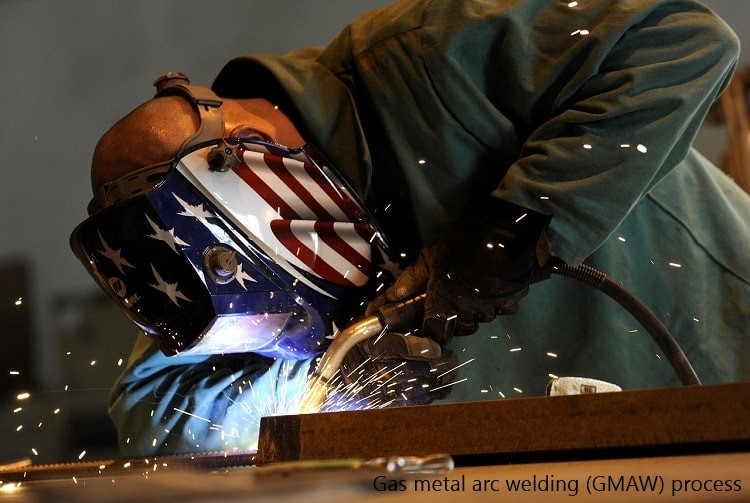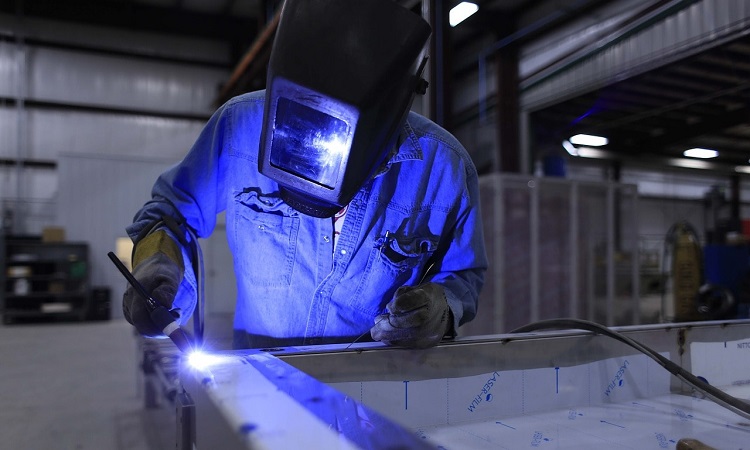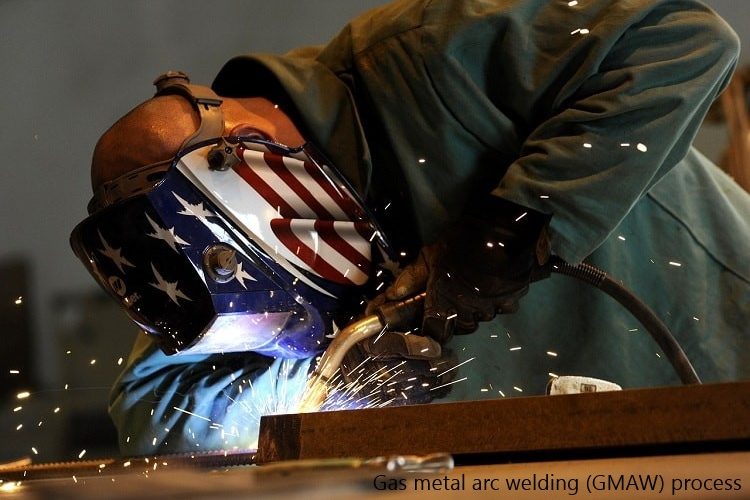Welding is one of the popular joining techniques that can permanently join two or more materials together with or without the application of heat, pressure and filler material. Fusion welding is that group of welding processes where faying surfaces of parent component are fused by heating in order to form coalescence. Arc welding is most popular fusion welding process where heat is applied by means of electric arc constituted between two electrodes under the presence of sufficient potential difference. There exist different arc welding processes to join variety of materials in diverse ways. Gas metal arc welding (GMAW) and Gas tungsten arc welding (GTAW) are two such arc welding processes that offer certain unique advantages.

Gas metal arc welding (GMAW) is one economic joining process in which coalescence is formed by melting faying surfaces and filler metal by means of electric arc constituted between consumable electrode and conductive parent metal. Since electrode is a consumable one so it is continuously fed at a constant rate by means of a mechanized wire feeder. So it cannot be performed in autogenous mode as consumable electrode is one integral part of the process. Suitable shielding gas (inert or active) can be used for protecting the weld bed from contamination. However, filler metal can be deposited on the weld bead at a faster rate and thus this process is productive and economic. If performed properly using optimum set of parameters, it can produce a sound and reliable joint.

Gas tungsten arc welding (GTAW), popularly known as tungsten inert gas (TIG) welding, is one sophisticated fusion welding process where joining is realized by coalescence formation due to fusion of faying surfaces. Here electric arc is constituted between conductive base material and non-consumable tungsten electrode. Since electrode is non-consumable one, filler material is required to apply separately when sufficient root gap exists. It is also favorable for autogenous mode of welding where no filler is applied. Shielding gas, preferably inert gas like argon, is also applied for protecting the hot metal pool during welding from atmospheric oxygen. Although is the process is comparatively slower, its capability of joining diverse metals and producing strong and reliable joints makes it one favorable process in many applications. Splendid weld bead appearance and defect-free joint are also two important advantages. GMAW differs from GTAW in many aspects and their differences are given below in table form.
Table: Differences between GMAW and GTAW welding processes
| Gas Metal Arc Welding (GMAW) | Gas Tungsten Arc Welding (GTAW) |
|---|---|
| GMAW utilizes a consumable electrode. So electrode material melts down and deposits on weld bead. | GTAW or TIG welding uses non-consumable electrode and thus electrode material is not deposited on weld bead. |
| Metallurgical composition of electrode material is similar to that of parent component. | Electrode is made of tungsten (with minor alloying elements) only. |
| It cannot be performed in autogenous mode as electrode material deposition is inherent to this process. | It is one favorable arc welding process for autogenous mode welding. |
| Since electrode provides necessary filler for filling root gap, so no external filler material is applied. | Filler material, if required, is applied externally usually in the form of small diameter rods. |
| GMAW process can utilize an inert or active shielding gas. | GTAW process mostly utilizes inert shielding gas. |
| GMAW process is much faster as electrode (or filler) is continuously fed by mechanized system. | GTAW is comparatively slower process. So it is not economically favorable. |
| GMAW process produces spatter, even if optimum set of parameters are used for welding. | GTAW is one spatter-free welding process. |
| Weld bead appearance is not so good. | It provides apparently splendid weld bead. |
| It is comparatively easier process to perform. | An experienced and attentive welder is desired to carry out this process. |
Consumable and non-consumable electrode: During arc welding, the electric arc is established between an electrode and conductive work materials. High heat density of this arc melts down faying surfaces of the parent components as well as filler metal if applied. When an electrode fuses and consequently deposits on weld bead during welding, it is termed as consumable electrode. In other word, when electrode is consumed for providing filler, it is called consumable electrode. In gas metal arc welding (GMAW), the electrode is consumable type as it melts down due to arc heating and subsequently deposits on weld bead. Contrary to this, in gas tungsten arc welding process (GTAW) process, electrode remains intact under intense arc heating. Since it does not melts down to deposit necessary filler metal, so it is non-consumable type. Consequently, life of GTAW electrode is higher than that for GMAW electrode.
Composition of electrode material: In GMAW, metallurgical composition of electrode (or filler) is more or less same with that of parent components, which are to be joined. GTAW always utilizes a pointed tungsten electrode, irrespective of the composition of parent material. However, few alloying elements (for example thorium, lanthanum oxide, cerium oxide, zirconia, etc.) are also added with tungsten for improving various welding characteristics like electron emissivity, electrode erosion, etc.
Possibility to perform in autogenous mode: An autogenous mode of welding is performed without applying any filler metal. Here root gap is maintained minimum, usually zero. During welding, only faying surfaces are fused by heating via electric arc and are allowed to cool down. The fused material of the two surfaces gets mixed and upon cooling it creates the weld bead. GMAW process inherently deposits filler metal on weld bead as it utilizes a consumable electrode. So it cannot be performed in autogenous mode. Since TIG welding utilizes a non-consumable electrode, so it can be advantageously performed in autogenous mode. In fact, it is one preferred welding process for joining in autogenous mode.
Application of filler metal externally: No filler metal is required to apply from external source in GMAW process as the electrode itself acts as filler metal. In TIG welding, however, filler can be applied separately if desired. Although TIG is preferred for autogenous mode joining, it can also be performed in homogeneous mode or heterogeneous mode. Filler in the form of small diameter rod can be fed to the weld zone beneath the electric arc at a constant pre-determined rate. This filler rod melts down due to arc heating and deposits necessary filler. Composition of this filler rod can be similar to that of work material or can be different; however, it must be compatible with parent metal otherwise defective joint will be produced.
Inert and active shielding gas: Shielding gas is used to protect hot weld bead from atmospheric oxygen by creating a protecting layer surrounding the entire weld zone. It also, directly or indirectly, help reducing spatter level, stabilizing arc and improving weld bead properties. This shielding gas can be inert or an active gas also. An active shielding gas can show better capability in certain situations. Such gases can also induce chemical elements on weld bead to improve various mechanical properties of the joint. GMAW process can utilize both types of shielding gas; and accordingly it can be classified into two groups—metal inert gas (MIG) and metal active gas (MAG). MIG utilizes only inert gas like argon, helium, etc. MAG utilizes active gas like carbon di-oxide, oxygen, etc., usually mixed with inert gas in different proportions. On the other hand, GTAW or TIG welding process uses inert gas only, predominantly argon.
GMAW is faster process compared to TIG: In GMAW process, electrode in the form of small diameter wire and wound in a pool is continuously fed by a proper mechanized arrangement. So filler can be deposited at a faster rate and consequently this welding process is highly productive as compared to TIG welding.
Spatter level and appearance: Spatter is small droplets of molten filer metal that is produced due to scattering of arc and come out from the welding zone. This spatter causes loss of filler metal and thus non-uniform filler deposition rate that sometime leads to various welding defects including negative reinforcement and dimensional inaccuracy. It also hampers appearance and requires grinding after welding for its removal. Many arc welding processes produce spatter including GMAW. It cannot be performed in spatter-free way even if optimum set of process parameters are used and proper welding technique is employed. TIG welding usually does not produce spatter unless the work material surface is not clean. Weld bead produced by TIG welding is smooth and superficially attractive.
Proficiency of welder: GMAW is quite easier to perform as most motions are automated. Even the movement of torch can be automated using suitable arrangement. Establishing arc is also easier. Compared to this, TIG welding is one sophisticated process and thus it requires experienced welder to carry out welding smoothly without arc blow or undesired arc termination. Establishing arc is quite crucial as tungsten electrode may stick to the work surface leading to tungsten inclusion defect.
Scientific comparison among Gas metal arc welding (GMAW) and Gas tungsten arc welding (GTAW) is presented in this article. The author also suggests you to go through the following references for better understanding of the topic.
- Tungsten inert gas (TIG or GTA) welding by TWI-Global.com.
- Gas Metal Arc Welding Handbook by W. H. Minnick (2007, Goodheart Willcox).
- Basic TIG & MIG Welding (GTAW & GMAW) by I. H. Griffin, E. M. Roden and C. W. Briggs (3rd edition, Delmar Cengage Learning).


